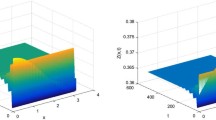Abstract
Plankton populations undergo dramatic surges. Rapid increases and decreases by a factor of 10 or more are observed, often separated by relatively stable interludes. We propose a description of plankton communities as excitable systems. In particular, we present a model for the evolution of phytoplankton and zooplankton populations which resembles models for the behaviour of excitable media. The parameter dependency of the various “excitable” phenomena, trigger mechanism, threshold, and slow recovery, is clear, and permits ready investigation of the influence of properties of the physical environment, including variations in nutrient fluxes, temperature or pollution levels.
Similar content being viewed by others
Literature
Busenberget al. 1990. The dynamics of a plankton-nutrient interaction.Bull. math. Biol. 52, 677.
Cloern, J. E. 1991. Tidal stirring and phytoplankton bloom dynamics in an estuary.J. mar. Res. 49, 203.
Grindrod, P. 1991.Patterns and Waves. Oxford: Oxford Universit Press.
Holling, C. S. 1959. The components of predation as revealed by a study of small mammal predation on the European pine sawfly.Can. Ent. 91, 293.
Iizuka, S.et al. 1989. Population growth ofGymnodinium nagasakiense red tide in Omura Bay. In:Red Tides: Biology, Environmental Science and Toxicology T. Okaichi (Ed.), p. 269. Amsterdam: Elsevier.
Iwasaki, H. 1989. Recent progress of red tide studies in Japan: an overview. In:Red Tides: Biology, Environmental Science and Toxicology. T. Okaichi (Ed.), p. 3. Amsterdam: Elsevier.
Levin, S. A and L. Segel. 1976. Hypothesis for the origin of plankton patchiness.Nature 259, 659.
Ludwig, D.et al. 1978. Quanlitative analysis of an insect outbreak system: the spruce budworm and forst.J. Anim. Ecol. 47, 315.
almeida Machado P. 1978. Dinoflagellate blooms on the Brazilian South Atlantic coast. In:Toxic Dinoflagellate Blooms. Taylor and Seliger (Eds), p. 29. Amsterdam: Elsevier/North-Holland.
Murray, J. M. 1990.Mathematical Biology, Berlin: Springer Verlag.
Morey-Baines, G. 1978. The ecological role of red tides in the Los Angeles-Long Beach Harbour food web. In:Toxic Dinoflagellate Blooms. Taylor and Seliger (Eds), p. 315. Amsterdam: Elsevier/North-Holland.
Nishijima, T. and Y. Hata. 1989. The dynamics of vitamin B12 and its relation to the outbreak ofChattonella red tides in Harima Nada, the Seto inland sea. In:Red. Tides: Biology, Environmental Science and Toxicology, T. Okaichi (Ed.), p. 257, Amsterdam: Elsevier.
Park, J. S.et al. 1989. Studies on red tide phenomena in Korean coastal waters. In:Red Tides: Biology, Environmental Science and Toxicology. T. Okaichi (Ed.), p. 37. Amsterdam: Elsevier.
Pingree, R. D.et al. 1975. Summer phytoplankton blooms and red tides along tidal fronts in the approaches to the English Channel.Nature 258, 672.
Provasoli, L. 1978. Recent progress: an overview. In:Toxic Dinoflagellate Blooms. Taylor and Seliger (Eds), p. 1. Amsterdam, Elsevier/North-Holland.
Satora, T. and A. Laws. 1989. Periodic blooms of the silicoflagellateDictyocha perlaevis in the subtropical inlet, Kaneohe Bay, Hawaii. In:Red Tides: Biology, Environmental Science and Toxicology, T. Okaichi (Ed.), p. 69, Amsterdam: Elsevier.
Tyson, J. and J. Keener. 1988. Singular perturbation theory of travelling waves in excitable media (a review).Physica D 32, 327.
Uye, S. 1986. Impact of copepod grazing on the red tide flagellateChattonella antiqua.Mar. Biol. 92, 35.
Wake, G.et al. 1991. Picoplankton and marine food chain dynamics in a variable mixed layer: a reaction-diffusion model.Ecol. modelling 57, 193.
Wyatt, T. and J. Horwood. 1973. Model which generates red tides.Nature 244, 238.
Author information
Authors and Affiliations
Rights and permissions
About this article
Cite this article
Truscott, J.E., Brindley, J. Ocean plankton populations as excitable media. Bltn Mathcal Biology 56, 981–998 (1994). https://doi.org/10.1007/BF02458277
Received:
Revised:
Issue Date:
DOI: https://doi.org/10.1007/BF02458277




